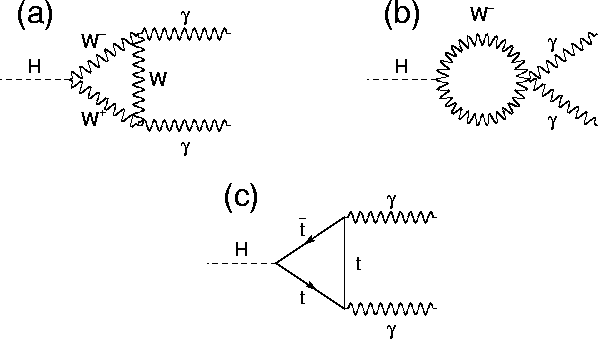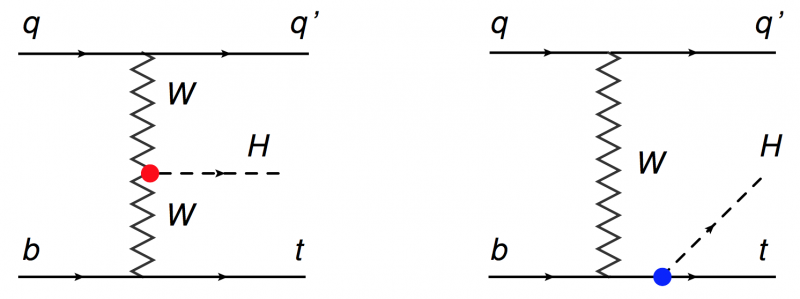One of the interesting things about finding a new particle is how much you can learn about it: from the manifold theory predictions for the Higgs boson that brought the Nobel Prize of 2013 to François Englert and Peter Higgs we have barely scratched the experimental surface.
We can understand the Higgs boson better by determining how it interacts -- or "couples" -- with other particles. Since these "couplings" are quantum mechanical in nature, they are governed by probability amplitudes, which may interfere with each other. If the probability amplitudes interfere constructively, we say that the relative sign of the couplings is the same, while if they interfere destructively, they have opposite relative signs. In all of the studies performed up to now, only the decay into two photons was sensitive to the relative sign of the coupling of the Higgs boson to fermions and bosons. This is because the Higgs boson decays into photons foremost via intermediary loops of W bosons and top quarks (see Image 1). The Standard Model predicts that the probability amplitude of decaying to two photons via W bosons interferes destructively with the probability amplitude of decaying via top quarks. If, however, the probability amplitudes interfere constructively, we would expect 2.3 times more decays of Higgs bosons to two photons than the Standard Model's prediction!

This interference effect -- which allows us to look for physics beyond the Standard Model -- can also be studied in instances where the Higgs boson (H) is produced along with one top quark (t) and another light quark (generically represented by q), known as tHq production. CMS presented results of the search for this tHq production at the Moriond meeting last week. A bottom quark from one of the colliding protons may emit a W boson that fuses with a W from another quark to form a Higgs (left-hand side of Image 2), resulting in a state with a Higgs, a top quark and a light quark. Alternatively, the bottom quark may exchange a W with another quark, producing a top quark. The top quark can then radiate a Higgs (as seen in the right-hand side of Image 2).

Although the same three products are produced in these interactions, you can see that one involves the Higgs interacting with W bosons while the other has a Higgs interacting with a top quark. What makes the tHq production particularly interesting is its high sensitivity to deviations from the Standard Model: if the above two coupling probabilities interfered constructively, the rate of production of this state would be a whopping 15 times higher than predictions!
On a more sobering note, looking for these signatures is extremely difficult. The search starts by identifying a top quark in the collision event through its decay into a W boson and a bottom quark, where the W itself decays into an electron (or a muon) and a neutrino while the bottom quark gives a jet of particles. Then it requires the presence of an additional jet of particles formed by the light quark. Finally, the Higgs itself is identified through its decay to two photons. That is a very complicated final state: two photons, two particle jets, an electron (or a muon) and an undetected neutrino!
One curious aspect of this analysis is to reject the result of the production of a Higgs boson with a top-quark pair (ttH) or in association with a W or Z boson (VH) both of which can mimic the tHq signature. Funnily enough, the ttH and VH Higgs production processes are themselves very rare, not yet "discovered" on their own, and here they are being treated as a nuisance that needs to be rejected!
As mentioned earlier, the distinctive feature of this search is that the effect of the interference in the tHq production is very large: constructive interference, or a flipped sign for the coupling of the top quark to the Higgs, would give a yield of events from tHq production that is 15 times larger than that expected in the SM. Below you can see the expected di-photon mass distribution after all analysis cuts as well as the data.

You can see four expected contributions drawn:
- Two solid contributions corresponding to the SM background from ttH and VH production, which the analysis does a good job of reducing.
- Two contributions corresponding to what is expected in case the top quark's coupling to the Higgs has a flipped sign.
By using the di-photon decay, this search maximises the expected effect. The hatched contribution ("Extra ttH") shows how the SM expectation for ttH and VH changes just from the effect of flipping the coupling on the decay to photons. In the absence of any observed events -- yes the legend is correct as the figure shows the (lack of) selected events -- it is possible to set a 95% CL upper limit of 4.1 times the expectation if the top quark’s coupling to the Higgs has a flipped sign. If the coupling is the SM one, then there is a very long way to go as the signal is 15 times smaller than what was searched for here.
This result nicely illustrates two things that might appear to be in contradiction but are not: (1) Nearly two years after its discovery, the Higgs boson is a background process and (2) there aren't any events surviving the selection, so there is still much data to be collected in coming years and a long way to go in order to unravel the detailed properties of the Higgs boson. CMS will keep looking.
The views expressed in CMS blogs are personal views of the author and do not necessarily represent official views of the CMS collaboration.
